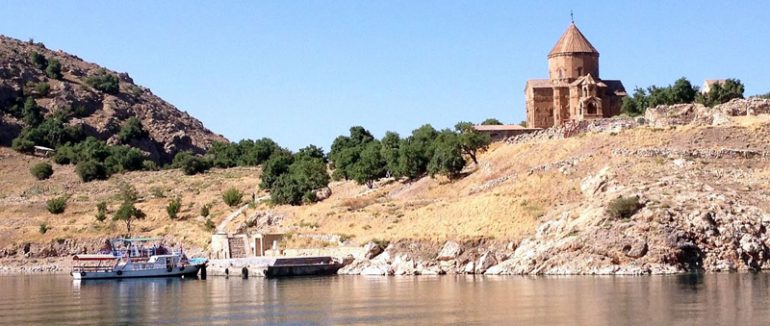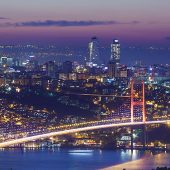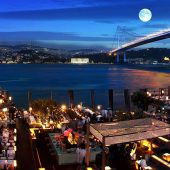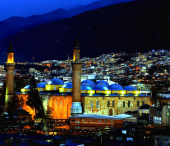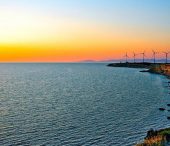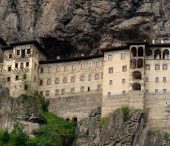Van is a city in eastern Turkey and the seat of Van Province, and is located on the eastern shore of Lake Van. The city's population in 2005 was 284,464. According to the Encyclopedia of the Orient, Kurds form the majority though no census based on ethnicity was ever held in Turkey.
History
Urartu
Under the ancient name of Tushpa, Van was the capital of the Urartian kingdom in the 9th century BC. Its ancient inhabitants called themselves Nairi. The early settlements are believed to have centered on the steep-sided bluff now known as Van Castle (Van Kalesi), close to the edge of Lake Van and a few kilometers west of the modern city. Here have been found Urartian cuneiform inscriptions dating to the 8th and 7th centuries BC.
From the Medes to the Sassanids
The region came under the control of the Medes in the early 7th century BC and later by Persians in the mid 6th century BC. In 331 BC, Van was conquered by Alexander the Great and after his death became part of the Seleucid Empire. By the early 2nd century BC it was part of the Kingdom of Armenia. It became an important center during the reign of the Armenian king, Tigranes II, who founded the city of Tigranakert in the 1st century BC. The Persian Sassanids finally gained control of the area in the 4th century AD.
The Byzantine Empire and Vaspurakan
The Byzantine Empire briefly held the region from 628 to 640, after which it was invaded by the Muslim Arabs, who consolidated their conquests as the province of Ermeniye. Decline in Arab power eventually allowed local Armenian rulers to re-emerge, with the Artsruni dynasty soon becoming the most powerful. Initially dependent on the rulers of the Kingdom of Ani, they declared their independence in 908, founding the kingdom of Vaspurakan. The kingdom had no specific capital: the court would move as the king transferred his residence from place to place, such as Van city, Vostan, Aghtamar, etc. In 1021 the last king of Vaspurakan, John-Senekerim Artsruni, ceded his entire kingdom to the Byzantine empire, who established the Vaspurakan theme on the former Artsruni territories.
The Seljuk Empire
Incursions by the Seljuk Turks into Vaspurakan started in the 1050s. After their victory in 1071 at the battle of Manzikert the entire region fell under their control. After them, local Muslim rulers emerged, such as the Ahlatshahs and the Ayyubids (1207). For a 20 year period Van was captured by the Anatolian Seljuk Sultanate, until the 1240s when it was conquered by the Mongols. In the 14th century Van was captured by the Kara Koyunlu Turks and later the Timurids.
The Ottoman Empire
The first half of the 15th century saw the Van region become a land of conflict as it was disputed by two Powers, namely the Ottoman Empire and the Persian Safavid Empire. The Safavids captured Van in 1502. The Ottomans took the city in 1515 and held it for a short period. The Safavids took it again in 1520 and Ottomans gained final and definite control of the city in 1548. They first made Van into a sanjak dependent on the Erzurum eyalet, and later into a separate Van eyalet in about 1570.
World War I
The city's Armenian population was devastated during World War I by Ottoman troops as a part of the Armenian Genocide. According to some Turkish accounts, with Russian forces approaching Lake Van the regional administrator ordered the execution of five Armenian leaders and a revolt resulted in Van on April 20, 1915 against the Turks and in favor of the Russians. However, most historians agree that the Armenian residents, hoping to avoid the slaughter inflicted on the rural population of Van, defended themselves in the Armenian quarters of the city against the Turks. The anti-Turkish and pro-Russian sentiments were in the hopes of being rescued from Turkish massacres. The Russians finally relieved the Armenian defenders of Van in late May of 1915.
In August, a victory over the Russian army allowed the Ottoman army to retake Van. In September of 1915 the Russians forced the Turks out of Van for the second time. Russian forces began to leave the area after the Russian Revolution of 1917 and by April 1918 it was recaptured by the Ottoman army. However, the end of World War I forced the Ottoman army to surrender its claim to Van.
Turkish War of Independence and Republic
At the Treaty of Sèvres, the Entente Powers decided to cede the city to the Democratic Republic of Armenia. Turkish revolutionaries, led by Mustafa Kemal Atatürk rejected the terms of the treaty and instead waged the Turkish War of Independence. By 1920, Van fell under Turkish control again and its remaining Armenian inhabitants were expelled. With the Treaty of Lausanne and Treaty of Kars, Treaty of Sèvres was annulled, and Van remained officially under Turkish sovereignty.
By the end of the war, the town of Van was empty and in ruins. The new city was rebuilt after the war a few kilometers east of the ancient citadel, which is now known as Van Castle (Van Kalesi). The city lies at about 1,750 metres (5,570 ft) above sea level. In the 1950s, the new city suffered from a devastating earthquake.
Van today
Van cat, Van, Turkey 1973, showing different coloured eyes
A number of sources affirm that Lake Van shelters a monster (Monster of Lake Van-Van Gölü Canavarı). A 4-meter high statue has been erected in its honor.The modern city is located on the plain extending from the Lake Van, at a distance of 5 kilometers from the lake shore.
It has often been called "The Pearl of the East" because of the beauty of its surrounding landscape. An old Armenian proverb in the same sense is "Van in this world, paradise in the next". This phrase has been slightly modified in Turkish as dünyada Van, ahirette iman or "Van for this world, faith for the next".
The city is home to Van Yüzüncü Yıl Üniversitesi (Van 100th Year University) and recently came to headlines in Turkey for two highly publicized investigations initiated by the Prosecutor of Van, one of which was focused on accusations against the university rector, Prof. Yücel Aşkın, who was kept in custody for a time.
In culinary terms, as some cities in Turkey became renowned for their like kebap culture or else, Van has distinguished itself with its breakfast culture.
The Turkish Van and Van Kedisi (Van Cat) are breeds of cat native to this town and named after it. The Turkish Van cat is noted for having different coloured eyes and enjoying swimming and rain.
On March 22nd, 2008 riots broke out in Van as the Newruz celebrations turned violent. The riots consisted mostly of young adults throwing rocks at police. damage included many broken windows.
Transport
Van is connected with Tatvan 96km away by train ferry which avoids the need to build 250km of railway through difficult terrain. This will be replace when traffic increases sufficiently.

